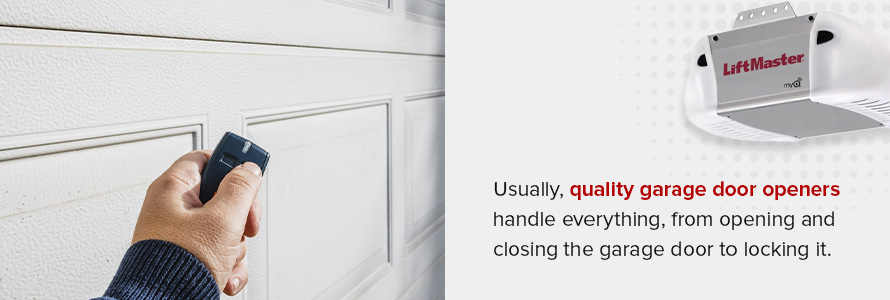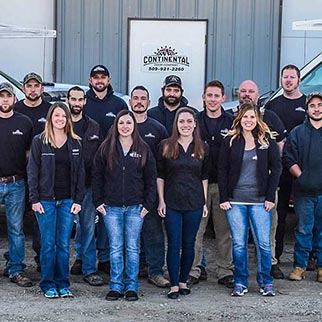Manual Garage Door Security Solutions
We live in a time when technology has automated many aspects of life, from your car’s transmission system to daily household operations. Garage doors are one of the areas that enjoy automation because nowadays, they come fit or designed to operate with garage door openers. These devices use electricity to open and close the garage door, and some come with a battery backup.
However, in the event of an extended power outage where the battery runs out, you’ll need another way to lock your garage door because the opener doesn’t work. This guide shows you how to lock a garage door manually.
How to Lock a Garage Door Manually From the Inside
It’s easy to manually lock garage doors from the inside if they already have a built-in locking system that serves as a backup when the door opener stops working. If your garage door has a built-in lock, simply slide the locking mechanism into place to prevent the door from opening from the outside. Before engaging the lock, however, disconnect your door opener so you can manually open and close the garage door. Doing that prevents automatic operation while the manual lock is in place, which can damage the door.
If your garage door doesn’t have a built-in locking system, you’ll need to install a manual feature. This can be as simple as inserting a padlock or zip tie through preexisting holes in the track. If you can’t find any holes in the track, you may have to drill them yourself to allow different locking methods, such as a padlock, a clamp or a slide lock.
It’s advisable to let a professional install a manual lock on your garage door to enhance security and prevent accidental damage to your door. As you wait out a power outage or repairs to your garage door opener, try a temporary locking solution like a C-clamp or vice grips. To lock a garage door manually from inside, stick the C-clamp on the track to prevent sliding.
How to Lock a Garage Door Manually From the Outside
Use a quick and easy solution like installing a hasp where the door touches the ground, and secure the garage door with a padlock. You could also weld loops on both sides of your garage door and secure it with strong padlocks if it’s a metal door. For wooden garage doors or those made from other materials, you could install a garage door kit since it comes with a key that allows you to lock and unlock your garage door from the outside.
There are two phases to installing a garage door kit. The lock has assemblies that you attach inside and outside the garage door. You first drill precise holes on the outside to drive the screws that hold the handle in place and then fit the matching assembly on the inside.
Installing a lock assembly on your garage door will allow you to lock it from the outside, but it can be a complex process as it requires exact measurements for proper installation. It’s best to let garage door service and repair experts handle the installation.
Types of Manual Locks for Garage Doors

Usually, quality garage door openers handle everything, from opening and closing the garage door to locking it. With that automatic feature unavailable, you’ll need to install a manual locking system. Here are common types of manual locks you can use:
1. Slide Locks
Slide locks function the same way as deadbolts but are a heavy-duty option for manually locking a garage door from the inside. You install a slide lock by screwing it at the edge of your garage door and making a hole in the tracks where the lock’s metal bar goes through. Since you need to push the bar through the hole in the tracks, you can only operate a slide lock from inside your garage.
2. Deadbolt Locks
Deadbolts are secure locks that drive a bolt into a hole in the tracks. They can be keyed or keyless. Keyed deadbolts require a key to activate the bolt, meaning you can install them on the outside. However, you can only operate a keyless deadbolt from inside your garage because you need to push the bolt into place to secure the door.
3. Keyed Locks
Keyed locks are some of the most effective in the market, ranging from traditional to modern and sophisticated ones. The most basic keyed locks are padlocks, which you can use to secure your garage door from the inside and outside. Their main advantage is that they are simple and effective once you make holes or hoops to run them through.
The more sophisticated and reliable keyed locks are T handles and L handles, which you assemble on both sides of the door to allow locking and unlocking from the outside. These locks are stronger and more challenging to intruders than padlocks.
Common Lock Issues and Troubleshooting
Manual garage door locks can experience problems even if they don’t rely on electricity. Here are common issues you may notice with your manual locks:
- Misalignment: Garage door misalignment is a common issue that may occur due to damage or aging. A misalignment can also shift your manual lock out of position. Check and tighten loose screws or correct the misalignment to resolve the issue.
- Key issues: Challenges with keyed locks include breakage and the inability to turn the key properly inside the lock. You may use a tool like long-nose pliers to remove the broken key stuck inside the lock. Lubricating the lock will also help you turn the key with ease.
- Corrosion and rust: Since your garage door is exposed to the elements, the manual lock mechanism may show signs of corrosion and rust, which can damage the lock over time. Clean the lock to remove dirt and debris, and use recommended rust removers to eliminate rust. You may also lubricate the lock to prevent further corrosion.
Frequently Asked Questions
Here are some FAQs about garage door locks:
Can You Lock a Garage Door Without Power?
If your power is out and you need to lock your garage door quickly, unplug the door opener and pull down the emergency release cord to put the door into manual mode. Then, find any type of clamping device and attach it to the tracks on top of the roller to prevent the door from going up.
How Do I Switch to the Automatic Lock?
Switching back to the automatic feature allows your door opener to operate its automatic lock. Pull the emergency release cord down and forward toward the door, and it’ll reengage the door opener. On your wall station, press the button to open the door. It’ll click and lift the door. The automatic lock will function normally the next time you close your garage door.
Improve Garage Door Security With Continental Door
Knowing how to manually lock a garage door is important because you never know when the need will arise. You can use the temporary clamping-the-tracks method to keep your garage safe. However, you may want to invest in a professional installation as a permanent solution.
Work with a reliable garage door company like Continental Door for services you can trust. If you’re a resident of the greater Spokane area, contact Continental Door for professional assistance!



